Comprehensive Guide to Numpy Concatenate Multiple Arrays: Mastering Array Joining in Python
Numpy concatenate multiple arrays is a powerful technique in the NumPy library that allows you to combine two or more arrays along a specified axis. This operation is essential for data manipulation and preprocessing in various scientific computing and data analysis tasks. In this comprehensive guide, we’ll explore the ins and outs of using numpy concatenate to join multiple arrays, providing detailed explanations and practical examples to help you master this crucial functionality.
Understanding the Basics of Numpy Concatenate Multiple Arrays
Before diving into the specifics of concatenating multiple arrays with NumPy, it’s important to grasp the fundamental concept. The numpy concatenate function is designed to join a sequence of arrays along an existing axis. This means you can combine arrays vertically, horizontally, or even along a third dimension, depending on your needs.
Let’s start with a simple example to illustrate how numpy concatenate works with multiple arrays:
import numpy as np
# Create three sample arrays
arr1 = np.array([[1, 2], [3, 4]])
arr2 = np.array([[5, 6], [7, 8]])
arr3 = np.array([[9, 10], [11, 12]])
# Concatenate the arrays vertically
result = np.concatenate((arr1, arr2, arr3), axis=0)
print("Concatenated arrays from numpyarray.com:")
print(result)
Output:

In this example, we create three 2×2 arrays and concatenate them vertically (along axis 0). The resulting array will have 6 rows and 2 columns. The numpy concatenate function takes a tuple of arrays as its first argument and the axis parameter to specify the direction of concatenation.
Exploring Different Axes for Numpy Concatenate Multiple Arrays
When working with numpy concatenate to join multiple arrays, understanding the concept of axes is crucial. The axis parameter determines the direction along which the arrays will be joined. Let’s explore different axis options:
Concatenating Along Axis 0 (Vertically)
Concatenating along axis 0 is the default behavior and results in stacking arrays vertically:
import numpy as np
arr1 = np.array([[1, 2], [3, 4]])
arr2 = np.array([[5, 6], [7, 8]])
arr3 = np.array([[9, 10], [11, 12]])
vertical_concat = np.concatenate((arr1, arr2, arr3), axis=0)
print("Vertical concatenation from numpyarray.com:")
print(vertical_concat)
Output:
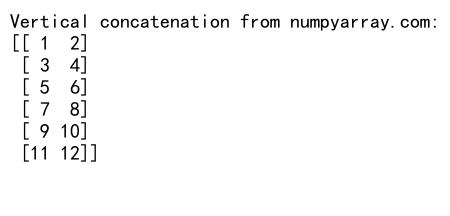
This example demonstrates how numpy concatenate joins multiple arrays vertically, resulting in a taller array.
Concatenating Along Axis 1 (Horizontally)
To concatenate arrays horizontally, we use axis=1:
import numpy as np
arr1 = np.array([[1, 2], [3, 4]])
arr2 = np.array([[5, 6], [7, 8]])
arr3 = np.array([[9, 10], [11, 12]])
horizontal_concat = np.concatenate((arr1, arr2, arr3), axis=1)
print("Horizontal concatenation from numpyarray.com:")
print(horizontal_concat)
Output:

This example shows how numpy concatenate can join multiple arrays side by side, creating a wider array.
Handling Arrays with Different Shapes
When using numpy concatenate to join multiple arrays, it’s important to consider the shapes of the input arrays. The arrays must have the same shape along all axes except the one being concatenated. Let’s look at some examples:
Concatenating Arrays with Compatible Shapes
import numpy as np
arr1 = np.array([[1, 2], [3, 4]])
arr2 = np.array([[5, 6]])
arr3 = np.array([[7, 8], [9, 10], [11, 12]])
result = np.concatenate((arr1, arr2, arr3), axis=0)
print("Concatenated arrays with compatible shapes from numpyarray.com:")
print(result)
Output:

In this example, all arrays have the same number of columns (2), so they can be concatenated vertically despite having different numbers of rows.
Handling Incompatible Shapes
If you try to concatenate arrays with incompatible shapes, NumPy will raise a ValueError. Here’s an example:
import numpy as np
arr1 = np.array([[1, 2], [3, 4]])
arr2 = np.array([[5, 6, 7], [8, 9, 10]])
try:
result = np.concatenate((arr1, arr2), axis=0)
except ValueError as e:
print(f"Error from numpyarray.com: {e}")
Output:

This code will raise an error because the arrays have different numbers of columns and cannot be concatenated vertically.
Advanced Techniques for Numpy Concatenate Multiple Arrays
Now that we’ve covered the basics, let’s explore some advanced techniques for using numpy concatenate with multiple arrays.
Concatenating Arrays of Different Dimensions
NumPy allows you to concatenate arrays of different dimensions, as long as they are compatible along the concatenation axis. Here’s an example:
import numpy as np
arr1 = np.array([1, 2, 3])
arr2 = np.array([[4, 5, 6], [7, 8, 9]])
result = np.concatenate((arr1.reshape(1, -1), arr2), axis=0)
print("Concatenated arrays of different dimensions from numpyarray.com:")
print(result)
Output:

In this example, we reshape the 1D array arr1 to a 2D array with one row before concatenating it with arr2.
Using Numpy Concatenate with Empty Arrays
You can also use numpy concatenate with empty arrays, which can be useful in certain scenarios:
import numpy as np
arr1 = np.array([[1, 2], [3, 4]])
empty_arr = np.empty((0, 2))
result = np.concatenate((arr1, empty_arr), axis=0)
print("Concatenated array with empty array from numpyarray.com:")
print(result)
Output:

This example demonstrates how numpy concatenate handles empty arrays, effectively leaving the original array unchanged.
Optimizing Performance with Numpy Concatenate Multiple Arrays
When working with large datasets, optimizing the performance of numpy concatenate operations becomes crucial. Here are some tips to improve efficiency:
Preallocating Memory
For repetitive concatenation operations, preallocating memory can significantly improve performance:
import numpy as np
# Create a list of arrays to concatenate
arrays = [np.random.rand(100, 100) for _ in range(10)]
# Preallocate memory for the result
total_rows = sum(arr.shape[0] for arr in arrays)
result = np.empty((total_rows, 100))
# Concatenate arrays into the preallocated memory
start = 0
for arr in arrays:
end = start + arr.shape[0]
result[start:end] = arr
start = end
print(f"Shape of concatenated array from numpyarray.com: {result.shape}")
Output:

This approach can be faster than using numpy concatenate directly, especially for a large number of arrays.
Using np.vstack and np.hstack
For simple vertical or horizontal concatenation, np.vstack and np.hstack can be more convenient:
import numpy as np
arr1 = np.array([[1, 2], [3, 4]])
arr2 = np.array([[5, 6], [7, 8]])
arr3 = np.array([[9, 10], [11, 12]])
vertical_stack = np.vstack((arr1, arr2, arr3))
horizontal_stack = np.hstack((arr1, arr2, arr3))
print("Vertical stack from numpyarray.com:")
print(vertical_stack)
print("\nHorizontal stack from numpyarray.com:")
print(horizontal_stack)
Output:

These functions are essentially wrappers around numpy concatenate but can be more intuitive for 2D arrays.
Handling Special Cases with Numpy Concatenate Multiple Arrays
Let’s explore some special cases and how to handle them when using numpy concatenate with multiple arrays.
Concatenating Arrays with Different Data Types
When concatenating arrays with different data types, NumPy will attempt to find a common data type that can represent all elements:
import numpy as np
arr1 = np.array([1, 2, 3], dtype=np.int32)
arr2 = np.array([4.5, 5.5, 6.5], dtype=np.float64)
result = np.concatenate((arr1, arr2))
print(f"Concatenated array from numpyarray.com: {result}")
print(f"Resulting data type: {result.dtype}")
Output:

In this case, the resulting array will have a float64 data type to accommodate both integer and floating-point values.
Concatenating Masked Arrays
NumPy’s masked arrays allow you to work with arrays that have missing or invalid data. Here’s how to concatenate masked arrays:
import numpy as np
import numpy.ma as ma
arr1 = ma.array([1, 2, 3], mask=[0, 0, 1])
arr2 = ma.array([4, 5, 6], mask=[1, 0, 0])
result = ma.concatenate((arr1, arr2))
print("Concatenated masked array from numpyarray.com:")
print(result)
print("Mask of concatenated array:")
print(result.mask)
Output:

This example demonstrates how numpy concatenate preserves the mask information when joining masked arrays.
Real-world Applications of Numpy Concatenate Multiple Arrays
Now that we’ve covered various aspects of using numpy concatenate with multiple arrays, let’s explore some real-world applications where this functionality is particularly useful.
Time Series Analysis
In time series analysis, you often need to combine data from different time periods. Here’s an example of how numpy concatenate can be used for this purpose:
import numpy as np
# Simulating monthly sales data for two years
year1_sales = np.random.randint(1000, 5000, (12, 1))
year2_sales = np.random.randint(1500, 5500, (12, 1))
# Adding month labels
months = np.array(['Jan', 'Feb', 'Mar', 'Apr', 'May', 'Jun', 'Jul', 'Aug', 'Sep', 'Oct', 'Nov', 'Dec'])
months = months.reshape(-1, 1)
# Concatenating data for both years
sales_data = np.concatenate((year1_sales, year2_sales), axis=0)
all_months = np.concatenate((months, months), axis=0)
# Combining months and sales data
result = np.concatenate((all_months, sales_data), axis=1)
print("Sales data for two years from numpyarray.com:")
print(result)
Output:

This example shows how numpy concatenate can be used to combine sales data from multiple years and add month labels.
Image Processing
In image processing, concatenating arrays is often used to create image mosaics or combine multiple channels. Here’s a simple example:
import numpy as np
# Simulating RGB channels of an image
red_channel = np.random.randint(0, 256, (100, 100))
green_channel = np.random.randint(0, 256, (100, 100))
blue_channel = np.random.randint(0, 256, (100, 100))
# Combining channels to create an RGB image
rgb_image = np.concatenate((red_channel[:,:,np.newaxis],
green_channel[:,:,np.newaxis],
blue_channel[:,:,np.newaxis]), axis=2)
print(f"Shape of RGB image from numpyarray.com: {rgb_image.shape}")
print(f"Data type of RGB image: {rgb_image.dtype}")
Output:

This example demonstrates how numpy concatenate can be used to combine individual color channels into a single RGB image.
Best Practices for Using Numpy Concatenate Multiple Arrays
To make the most of numpy concatenate when working with multiple arrays, consider the following best practices:
- Check array shapes: Always verify that the arrays you’re concatenating have compatible shapes along the non-concatenating axes.
-
Use appropriate axis: Choose the correct axis for concatenation based on your desired output structure.
-
Consider memory usage: For large arrays, be mindful of memory consumption and consider using memory-efficient approaches like preallocating arrays.
-
Handle data types: Be aware of how NumPy handles different data types during concatenation and explicitly set the desired data type if needed.
-
Use alternatives when appropriate: For simple cases, consider using np.vstack or np.hstack as more intuitive alternatives to numpy concatenate.
Here’s an example that incorporates some of these best practices:
import numpy as np
def safe_concatenate(arrays, axis=0):
"""
Safely concatenate arrays after checking shapes and data types.
"""
if not arrays:
return np.array([])
# Check shapes
shapes = [arr.shape for arr in arrays]
if len(set(shape[:axis] + shape[axis+1:] for shape in shapes)) > 1:
raise ValueError("Arrays must have the same shape except along the concatenation axis.")
# Find common data type
common_dtype = np.find_common_type([arr.dtype for arr in arrays], [])
# Concatenate arrays
result = np.concatenate(arrays, axis=axis).astype(common_dtype)
return result
# Example usage
arr1 = np.array([[1, 2], [3, 4]])
arr2 = np.array([[5.5, 6.5], [7.5, 8.5]])
arr3 = np.array([[9, 10], [11, 12]])
try:
result = safe_concatenate([arr1, arr2, arr3], axis=0)
print("Safely concatenated arrays from numpyarray.com:")
print(result)
print(f"Resulting data type: {result.dtype}")
except ValueError as e:
print(f"Error from numpyarray.com: {e}")
This example demonstrates a safe concatenation function that checks for shape compatibility and handles data type conversion.
Troubleshooting Common Issues with Numpy Concatenate Multiple Arrays
When working with numpy concatenate to join multiple arrays, you may encounter some common issues. Here are some problems you might face and how to resolve them:
Dealing with Dimension Mismatch
One common error occurs when trying to concatenate arrays with mismatched dimensions:
import numpy as np
arr1 = np.array([1, 2, 3])
arr2 = np.array([[4, 5, 6], [7, 8, 9]])
try:
result = np.concatenate((arr1, arr2), axis=0)
except ValueError as e:
print(f"Error from numpyarray.com: {e}")
# Fix: Reshape arr1 to match arr2's dimensions
arr1_reshaped = arr1.reshape(1, -1)
result = np.concatenate((arr1_reshaped, arr2), axis=0)
print("Fixed concatenation:")
print(result)
Output:

This example shows how to handle and fix a dimension mismatch error by reshaping one of the arrays.
Handling Memory Errors
When working with very large arrays, you might encounter memory errors. Here’s an approach to handle this issue:
import numpy as np
def concatenate_in_chunks(arrays, axis=0, chunk_size=1000):
"""
Concatenate large arrays in chunks to avoid memory errors.
"""
result = []
for i in range(0, len(arrays), chunk_size):
chunk = arrays[i:i+chunk_size]
result.append(np.concatenate(chunk, axis=axis))
return np.concatenate(result, axis=axis)
# Example usage with simulated large arrays
large_arrays = [np.random.rand(1000, 100)for _ in range(10000)]
try:
result = concatenate_in_chunks(large_arrays, axis=0)
print(f"Shape of concatenated large arrays from numpyarray.com: {result.shape}")
except MemoryError as e:
print(f"Memory error from numpyarray.com: {e}")
Output:

This example demonstrates a function that concatenates large arrays in chunks to avoid memory errors.
Advanced Applications of Numpy Concatenate Multiple Arrays
Let’s explore some more advanced applications of numpy concatenate with multiple arrays.
Creating Sliding Windows
Numpy concatenate can be used to create sliding windows for time series analysis or signal processing:
import numpy as np
def create_sliding_windows(data, window_size, step_size=1):
"""
Create sliding windows from a 1D array.
"""
num_windows = (len(data) - window_size) // step_size + 1
windows = np.array([data[i:i+window_size] for i in range(0, num_windows * step_size, step_size)])
return windows
# Example usage
time_series = np.array([1, 2, 3, 4, 5, 6, 7, 8, 9, 10])
windows = create_sliding_windows(time_series, window_size=3, step_size=1)
print("Sliding windows from numpyarray.com:")
print(windows)
Output:
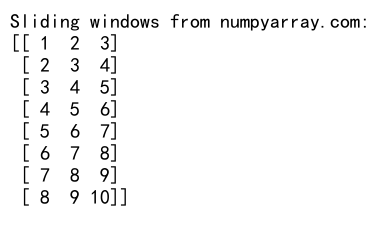
This example shows how to use numpy concatenate implicitly to create sliding windows from a time series.
Implementing a Rolling Join
Numpy concatenate can be used to implement a rolling join operation, which is useful in financial analysis and other domains:
import numpy as np
def rolling_join(arr1, arr2, window_size):
"""
Perform a rolling join of two arrays.
"""
result = []
for i in range(len(arr1) - window_size + 1):
window = arr1[i:i+window_size]
joined = np.concatenate((window, [arr2[i+window_size-1]]))
result.append(joined)
return np.array(result)
# Example usage
prices = np.array([100, 102, 104, 103, 105, 107, 106, 108])
volumes = np.array([1000, 1200, 1100, 1300, 1400, 1200, 1500, 1600])
rolling_data = rolling_join(prices, volumes, window_size=3)
print("Rolling join result from numpyarray.com:")
print(rolling_data)
Output:
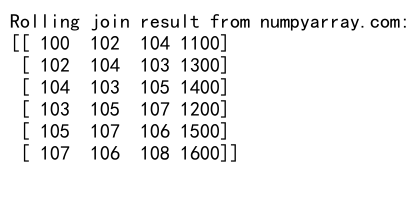
This example demonstrates how to use numpy concatenate to implement a rolling join operation on two arrays.
Comparing Numpy Concatenate with Other Array Joining Methods
While numpy concatenate is a powerful and flexible method for joining multiple arrays, it’s worth comparing it with other array joining methods in NumPy. Let’s explore some alternatives and their use cases:
Numpy Stack
Numpy stack is useful when you want to create a new axis while combining arrays:
import numpy as np
arr1 = np.array([1, 2, 3])
arr2 = np.array([4, 5, 6])
arr3 = np.array([7, 8, 9])
stacked = np.stack((arr1, arr2, arr3))
print("Stacked arrays from numpyarray.com:")
print(stacked)
print(f"Shape of stacked array: {stacked.shape}")
Output:
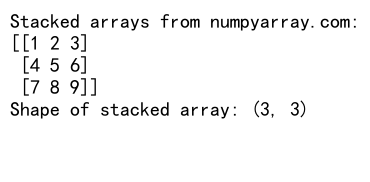
This example shows how np.stack creates a new axis to combine the arrays, resulting in a 2D array.
Numpy Column_stack and Row_stack
These functions are convenient for working with 1D arrays:
import numpy as np
arr1 = np.array([1, 2, 3])
arr2 = np.array([4, 5, 6])
arr3 = np.array([7, 8, 9])
col_stacked = np.column_stack((arr1, arr2, arr3))
row_stacked = np.row_stack((arr1, arr2, arr3))
print("Column-stacked arrays from numpyarray.com:")
print(col_stacked)
print("\nRow-stacked arrays from numpyarray.com:")
print(row_stacked)
Output:
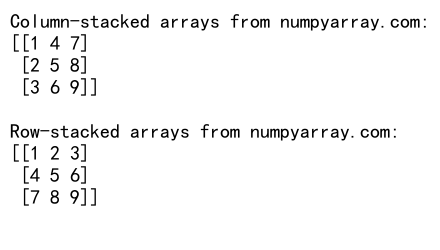
This example demonstrates how np.column_stack and np.row_stack can be used to combine 1D arrays into 2D arrays.
Conclusion: Mastering Numpy Concatenate Multiple Arrays
In this comprehensive guide, we’ve explored the various aspects of using numpy concatenate to join multiple arrays. We’ve covered basic usage, advanced techniques, real-world applications, best practices, and troubleshooting common issues. By mastering numpy concatenate, you’ll be well-equipped to handle a wide range of array manipulation tasks in your data analysis and scientific computing projects.
Remember these key points when working with numpy concatenate multiple arrays:
- Always check the shapes and data types of the arrays you’re concatenating.
- Choose the appropriate axis for concatenation based on your desired output.
- Consider memory usage and performance optimization techniques for large arrays.
- Explore alternative methods like np.vstack, np.hstack, and np.stack for specific use cases.
- Handle errors gracefully and implement safeguards in your code.
By applying these principles and the techniques we’ve discussed, you’ll be able to efficiently and effectively use numpy concatenate to join multiple arrays in your Python projects. Whether you’re working on time series analysis, image processing, or any other data-intensive task, the ability to concatenate arrays is a valuable skill in your NumPy toolkit.